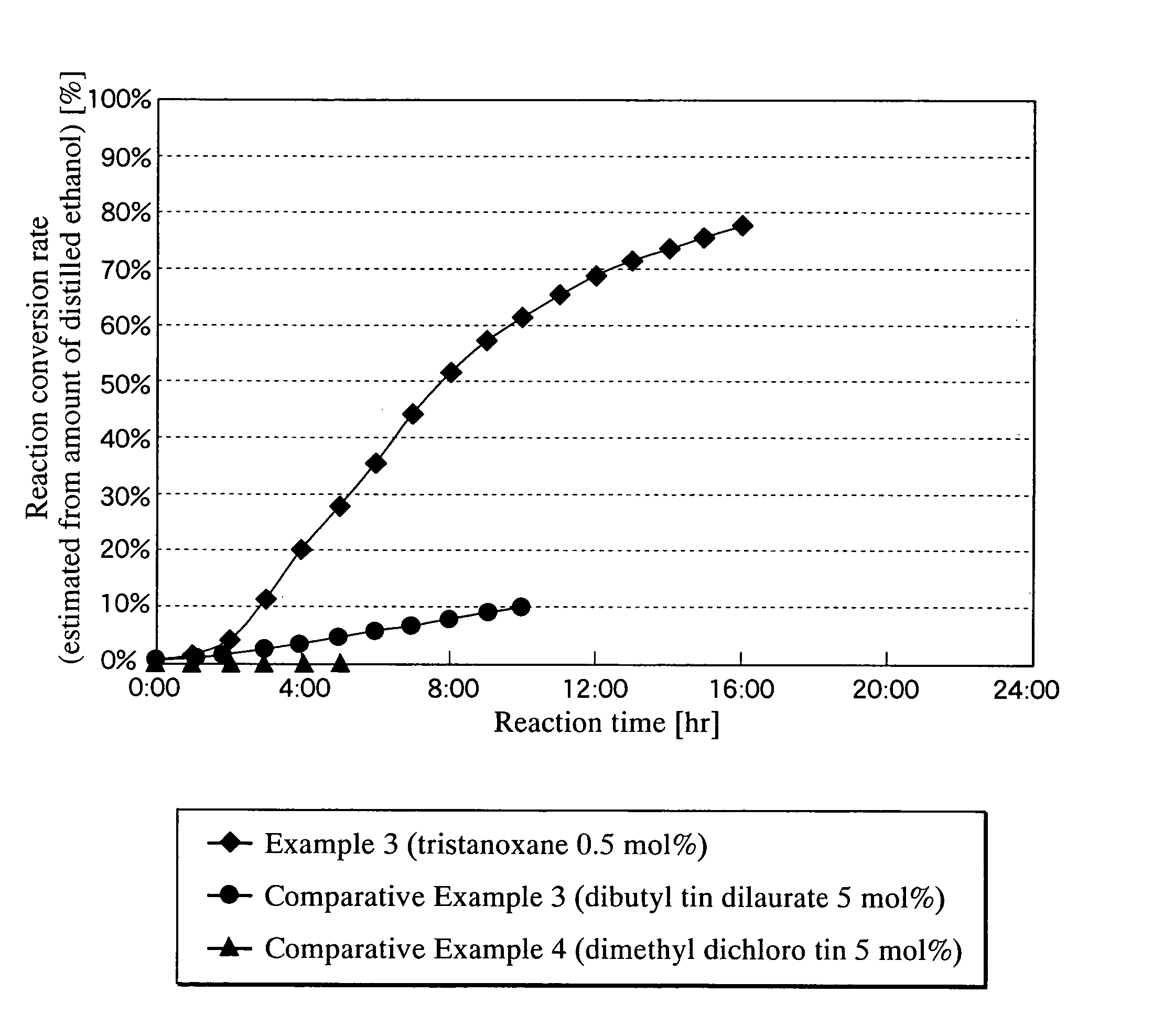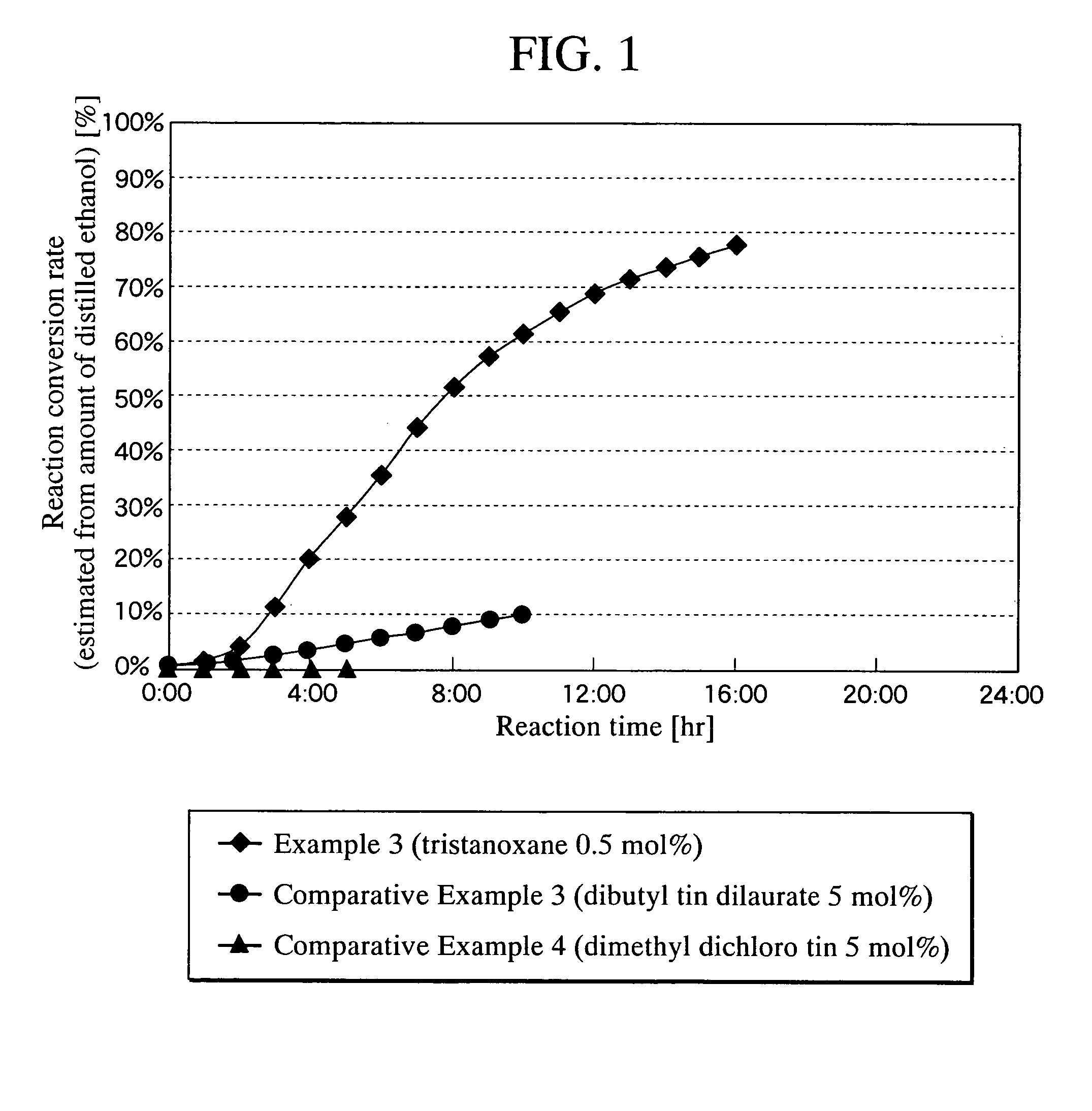Process for producing polymerizable polybranched polyester
a polymerizable, hyperbranched technology, applied in the preparation of organic compounds, transesterification, stabilisation of lactams, etc., can solve the problems of reduced number of unsaturated double bonds introduced into the molecular terminals, increased susceptibility to gelling of the reaction system, and occurrence of side reactions. , to achieve the effect of high efficiency
- Summary
- Abstract
- Description
- Claims
- Application Information
AI Technical Summary
Benefits of technology
Problems solved by technology
Method used
Image
Examples
synthesis example 1
Synthesis of Cl (Sn(CH3)2O)2Sn(CH3)2Cl
[0087]This compound was synthesized in accordance with the process described in the Journal of the Society of Chemical Industry (Vol. 73, p. 1010, 1970). As a result of elementary analysis, the product consisted of Sn=64.7% (theoretical value: 64.8%) and Cl=12.7% (theoretical value: 12.9%), which agreed with the theoretical values of Cl(Sn(CH3)2O)2Sn (CH3)2Cl. (This compound is referred to as the tristanoxane obtained in Synthesis Example 1).
example 1
[0088]10 parts of Boltorn H40, 0.25 parts of the tristanoxane obtained in Synthesis Example 1, 100 parts of ethyl acrylate and 0.05 parts of hydroquinone were added to a reaction vessel equipped with a stirrer, a gas bubbling tube, thermometer and Dean-Stark decanter provided with condenser, followed by heating while stirring and blowing into the mixed solution a mixed gas of nitrogen and oxygen (oxygen content: 7% by volume) through the gas bubbling tube at the rate of 3 ml / min. At this time, the heating power was adjusted so that the amount of distillate to the decanter was 15 to 20 parts per hour (reaction temperature: 92° C. to 95° C.), the distillate in the decanter was removed every hour and an equal amount of fresh ethyl acrylate was added to the reaction vessel, and the reaction was carried out for 20 hours.
[0089]Following completion of the reaction, the residue obtained by distilling off the unreacted ethyl acrylate from the reaction mixture under reduced pressure, was diss...
example 2
[0090]10 parts of Boltorn H40, 1.25 parts of dibutyl tin oxide, 100 parts of methyl methacrylate and 0.05 parts of hydroquinone were added to a reaction vessel equipped with a stirrer, a gas bubbling tube, thermometer and Dean-Stark decanter provided with condenser, followed by heating while stirring and blowing into the mixed solution a mixed gas of nitrogen and oxygen (oxygen content: 7% by volume) through the gas bubbling tube at the rate of 3 ml / min. At this time, the heating power was adjusted so that the amount of distillate to the decanter was 15 to 20 parts per hour (reaction temperature: 92° C. to 95° C.), the distillate in the decanter was removed every hour and an equal amount of fresh ethyl acrylate was added to the reaction vessel, and the reaction was carried out for 12 hours.
[0091]Following completion of the reaction, the unreacted methyl methacrylate was distilled off from the reaction mixture under reduced pressure. Then, 10 parts of acetic acid anhydride and 2 part...
PUM
| Property | Measurement | Unit |
|---|---|---|
| temperature | aaaaa | aaaaa |
| temperature | aaaaa | aaaaa |
| reaction temperature | aaaaa | aaaaa |
Abstract
Description
Claims
Application Information
 Login to View More
Login to View More - R&D
- Intellectual Property
- Life Sciences
- Materials
- Tech Scout
- Unparalleled Data Quality
- Higher Quality Content
- 60% Fewer Hallucinations
Browse by: Latest US Patents, China's latest patents, Technical Efficacy Thesaurus, Application Domain, Technology Topic, Popular Technical Reports.
© 2025 PatSnap. All rights reserved.Legal|Privacy policy|Modern Slavery Act Transparency Statement|Sitemap|About US| Contact US: help@patsnap.com



